When one thinks of family, invariable thoughts run to family meals – celebrations with family over holidays or other special events. Many times one serves certain family recipes at these meals, and sometimes a specific recipe is associated with a specific holiday every year. However, it seems to me that recipes also have a way of getting lost over the years. How many of us make the exact same recipes that our families made in previous generations? Sure, many of us make ‘ethnic’ recipes from the countries our families came from, but how many are actual family recipes and how many came from cookbooks or web sites? In many cases those original recipes were lost not because they were forgotten, but because modern conveniences like microwaves and food processors, as well as a desire to fit in to their new communities, changed the way our families cooked, and simpler recipes replaced more complex ‘authentic’ recipes they had made when they first arrived on new shores. Convenience played another role in changing recipes, as sometimes the ingredients available one place were not available in one’s new home, and ingredients were substituted, forever changing the recipes.
With all of this in mind, it was interesting when my mother-in-law came to visit us in Israel recently and decided to teach my wife how to make Kubbe. My mother-in-law was born in Iraq, and moved to Israel as a child due to the increasing violence and discrimination against Jews in Iraq in the early 1950s. As a teenager she went to college in the United States, where my wife grew up. When my wife was growing up, her grandmother used to come and visit and make authentic foods she learned to make in Iraq. One of the spotlights of her culinary repertoire was Kubbe. When her grandmother passed away, the Kubbe stopped as her mother never made it when my wife was growing up.
Kubbe comes in many forms, and varies from country to country in the Middle East. The spelling also varies greatly in English – Kubbe, Kube, Kubba, Kibbe, etc.
When I was growing up, the only Kubbe I was aware of was the football-shaped fried Syrian variety. Iraq also has a fried variety, but it’s generally larger and rounder. Iraq is also home to a boiled form, that is cooked in a soup and served over a bed of rice. The boiled form is sold across Israel as a soup in a number of different flavorings – Kubbe Selek (Beet) is a very popular one due to its sweetness and bright color, and other flavoring such as lemon and tomato exist in restaurants across Israel, brought here by the large population of Jews from across the Middle East. My wife’s family from Iraq made three specific flavors of this Kubbe – Beet, Pumpkin and Okra. When my wife was pregnant with our first child, her mother let us in on a little secret – she knew how to make Kubbe, and she knew how to do it really well. She hadn’t wanted to get into the stereotype of the Sephardi wife making all of these specialty foods when she was a young wife, but now she decided to make us a batch of Kubbe. My wife was in shock. That was nearly five years ago, and over the years she made it a few more times, but on this trip she decided to teach my wife the ins and outs of making Kubbe. On this trip, she made Kubbe with Beets, Kubbe with Pumpkin, and fried Kubbe, and showed my wife how to do all of them.
The genealogist in me saw this is as passing down an oral tradition, and decided to document it. Researching Jewish genealogy in Iraq may be close to impossible, but at least there is this family hisotry in the form of food that was passed down and we can continue to share. My nerdiness is your gain, as the remainder of this article is a photo-rich step-by-step guide in making Iraqi Kubbe, with either Beets or Pumpkin. If you like Okra, sorry, we don’t, so we never asked how to make that one…
More or less, there are no secret ingredients used to make this dish. There are a few specialty ingredients, but these are easy to find these days. In Israel any gourmet food store or spice store will carry what you need, and in the US you can order most of this online (except maybe the Noomi Basra – more on that later). However, even without these few special ingredients, you can make this recipe and it will be pretty good, if not as tart. If you don’t like tart foods, then you might want to skip some of these ingredients anyways. In general it’s good to think of this as a sweet and sour dish, and if you don’t have one of the sweet or sour ingredients, just substitute them with something you do have.
There are three main components to making this Kubbe – the dough, the meat and the soup. The best part about this recipe is that the two versions you see photos of at the top only differ in one ingredient – you either add pumpkin or you add beets when you get to that stage. The rest of the recipe is exactly the same.
With a little practice, from beginning to having the soup cooking should take between an hour and and hour and a half. Once it’s cooking you need to stir occasionally, but basically you leave it alone for at least half an hour. So, making this can range from an hour and a half to two hours or thereabouts.
Dough
Let’s start with the dough. It’s a good place to start because it’s easy and it needs to sit for 20-30 minutes after you first knead it, so you might as well get it over with first. The recipe is just three ingredients:
| Dough | |
|---|---|
| 3 Cups | Farina/Cream of Wheat/Solet |
| 2 tsp | Salt |
| 1 1/2 Cup | Water |
The main ingredient is Cream of Wheat (in the US). In the UK it’s known as Farina. In Israel it’s Solet. Basically a coarsely ground wheat product.
Originally in Iraq they used to grind rice for this purpose instead of using Farina. This is a change made after leaving Iraq, but is fairly universal. If I had to guess, this switch was due to the shortage of rice in Israel during the same period when most Jewish immigrants from Arab countries arrived.
This problem also led to the creation of Ptitim, known outside of Israel as Israeli Couscous, as a substitute for rice. The origin of Ptitim is quite amazing – David Ben Gurion, the first Prime Minister of Israel, asked Osem, a major food company in Israel, to develop a wheat-based replacement for rice, since rice was a major staple of the diet of Jews from the surrounding countries. Anyways…
You mix the ingredients together in a bowl and knead until it’s slightly elastic.
 |
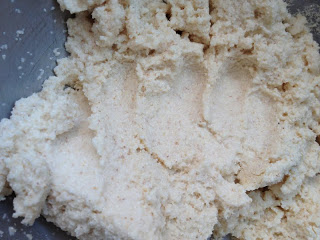 |
| Knead until slightly elastic | Dough after waiting 20-30 minutes |
After kneading the dough, you need to let it sit for 20-30 minutes, so set it aside and start on the next step.
The Meat
The meat is pretty simple. Basically it’s chopped meat, onions, parsley, with rice and some spices.
 |
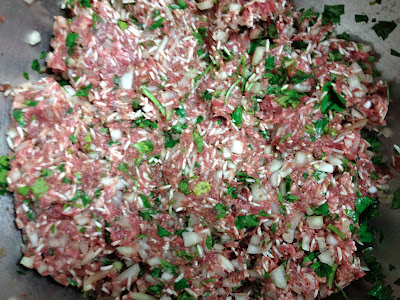 |
| Chopping Parsley | Finished Meat Mixture |
Here’s the ingredient list:
| Meat Mixture | |
|---|---|
| 1 lb | Ground Beef |
| 1/2 Cup | Rinsed, Uncooked Rice (Basmati is good) |
| 1 Cup | Parsely, Finely Chopped |
| 2 | Onions (Medium), Finely Chopped |
| 2 tsp | Baharat Spice Mixture (see notes below) |
| 2 tsp | Salt |
| 1 tsp | Cinnamon |
| 1 tsp | Black Pepper, ground |
Chop the onions and parsley very fine. Rinse the rice, then drain the water. Add the everything together in a bowl and mix together. You can do this step in advance if you want, and store for up to a day. However, it takes so little time you can do it in between the dough and the soup without much problem.
What, you might be asking, is Baharat? Baharat is one of the three specialty ingredients in this recipe, and it’s used in both the meat mixture and in the soup. In Arabic, Baharat simply means spices. Baharat is a common spice mixture that is used across the middle east, but it varies by region. Thus Baharat in Iraq is not the same as that in Lebanon, which is not the same as that in Turkey. Indeed, the exact mixtures probably vary by family.
In Israel almost any spice store (and there are many of them) will carry Baharat – just ask for it. In the US, speciality food stores will carry some form of it, or you can look on Amazon, which has several varieties of it, even kosher-certified organic mixtures. If you don’t want to, or can’t, buy Baharat where you live, you can make you own with the following recipe:
| Baharat (All ground) | |
|---|---|
| 2 Tbsp | Black Pepper |
| 2 Tbsp | Cumin |
| 2 Tbsp | Paprika |
| 1 Tbsp | Cloves |
| 1 Tbsp | Coriander |
| 1 tsp | Cinnamon |
| 1 tsp | Nutmeg |
| 1/2 tsp | Carnomon |
Starting the Soup
We’re just going to put a few ingredients in a stock pot to get started, as they also need time. Here’s what you need:
| Soup Starter | |
|---|---|
| 2 | Onions, coarsely chopped |
| 2 Tbsp | Olive Oil |
| 2 Cups | Beets or Pumpkin |
Start out by adding the olive oil and onions to the stock pot and brown the onions. Peel and cut the Pumpkin or Beets into bite-size cubes. When the onions are browned, add the Pumpkin or Beets and let that cook too. You can leave it cooking for 10-15 minutes until you’re ready to add the flavoring and water.
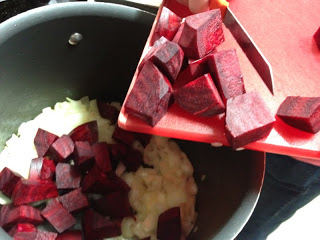 |
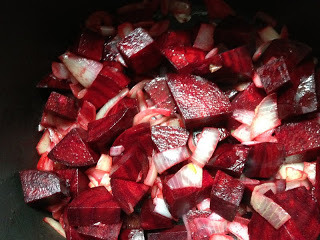 |
| Adding Beets to the pot | Onions and Beets cooking |
While the onions and the Pumpkin or Beets are cooking, move on to the next step…
The Soup Flavor
As mentioned earlier, the basis of both the Pumpkin and Beet soups is identical. Here’s how to flavor the soup that you’ll be boiling the Kubbe in.
| Soup Flavoring | |
|---|---|
| 3 | Lemons (Juice of) |
| 1/2 Cup | Tamarind Concentrate |
| 1/2 Cup | Brown Sugar |
| 1/2 Cup | Olive Oil |
| 2 tsp | Baharat Spice Mixture (see notes above) |
| 1 tsp | Cinnamon |
| 2 tsp | Salt |
| 1 | Noomi Basra (Black Lemon) – see notes below |
| 14 Cups | Water, approximate |
Mix the ingredients of the soup flavoring together in a bowl with 2 Cups of Water, and whisk together. Make sure the Tamarind concentrate gets fully mixed together with the other ingredients.
Tamarind is the second specialty ingredient used in this recipe. It adds a lot of tart tangy flavor to the final dish, and is highly recommended. You’ll probably find other uses for Tamarind once you start using it. Like Baharat, this is fairly easy to find in Israel, and in the US you can find it in specialty stores and yes, even on Amazon. For those worried about it being kosher, the one here comes with kosher certification and the same brand is sold on Amazon, but I don’t know if it kosher certified or not.
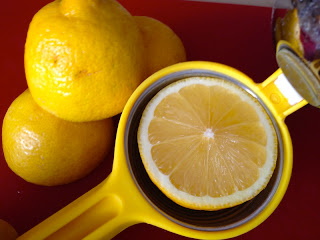 |
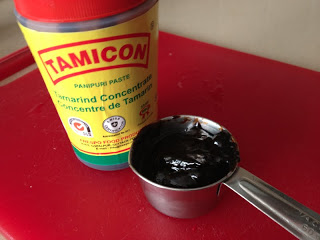 |
| Juicing Lemons | Tamarind Concentrate |
Taste the mixture for future reference – if you find the flavor of the final product is not tart enough, or not salty enough, etc. then this is a good point to check and to adjust it in the future.
Add this to the stock pot with the additional 12 cups of water. Basically you want to add enough water to have room for all the Kubbe you’re going to add soon. Make sure you don’t add too much water, however, or the pot can overflow when you add the Kubbe.
If you can find a Noomi Basra (literally a Basra Lemon, but it’s actually a dried Lime) add this as well – it will add more tart citrus flavor. In English it’s called a Black Lime. You can pierce the Noomi Basra a couple of times before adding it, or crush it and add the pieces to the soup. This is the third and last specialty ingredient in the recipe, and the hardest to find. In much of the Arab world, this is called Loomi. In Iraq, they are called Noomi Basra (Basra Lemon), after the town of Basra in Iraq. As I found out about them from my mother-in-law, I refer to them by their Iraqi name. In Israel, they’re called Persian Lemons. In Persia (Iran), it’s called Omani, after the country of Oman. Basically, it’s a lime that is boiled in salt water, then dried out in the sun. It gives a very unique tart citrus flavor to the dish, more complex than the lemon or the tamarind concentrate by themselves.
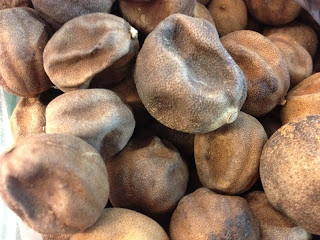 |
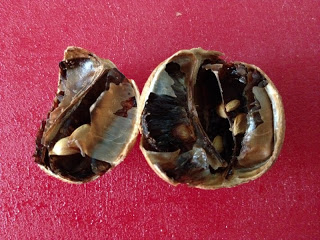 |
| Noomi Basra in the Market | A Noomi Basra Cracked Open |
Bring to a rapid boil. The soup needs to be boiling strongly when you add the Kubbe.
Making the Kubbe (a trick that makes it easy)
For many people, Kubbe seems daunting because the idea of forming all the Kubbe balls and having them come out right seems impossible. Indeed, I don’t think my wife ever expected to make Kubbe because of this fact. However, while she was learning to make Kubbe from her mother, she ran into an unexpected stroke of luck. Her cousin came to visit and her cousin, who has made Kubbe before, learned a trick for making a type of cookie that she applied to making Kubbe, making it much simpler, and the result much better. Basically, you oil a cutting board and your hands, and you take a piece of dough and make a circle about 3 inches across. Since the board and your hands are oiled, the dough doesn’t stick to the board. Add the meat, pull the dough up around the meat, and roll it in your oiled hands. Perfect thin-walled Kubbe, better than many old Iraqi women who have been making Kubbe for decades can make.
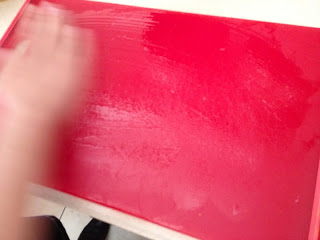 |
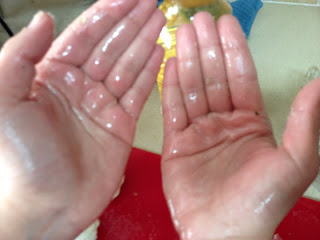 |
| Oil your workspace… | …and your hands |
To make the Kubbe balls, you want to start by taking the dough that you made earlier. Knead it a little and test it out by taking a piece off and seeing if it is easy to work with. If you find it too liquidy or otherwise falling apart, you can add some plain flour to the dough to get the consistency better. If you do that, make sure to knead it all together and wait a few more minutes. If you want, you can separate the dough into pieces in advance, or you can just take pieces from the dough as you go.
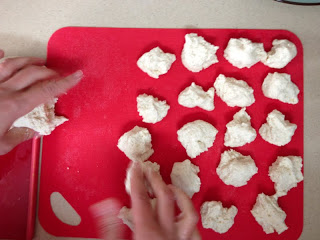 |
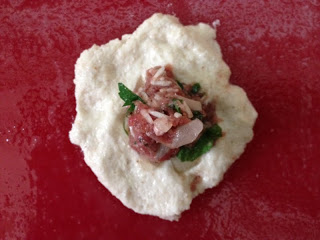 |
| Separating the dough | Spreading the dough and adding meat |
As mentioned before, you now take a piece of dough, and spread it out into a circle. Add some meat. Pull the dough up around the meat and push it together. Once it’s sticking, roll it in your hands to make it round. If there’s hole in the dough, you can patch it with more dough.
Two more recommendations. Add additional oil the board and your hands as necessary during the process. Also, keep a bowl with some water it in nearby so you can rinse off pieces of meat or other debris from you hands as you go, otherwise you might end up with pieces of meat on the outside of the Kubbe balls. It’s not a big deal, but if you’re a perfectionist, having the water nearby is handy.
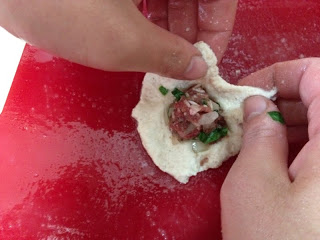 |
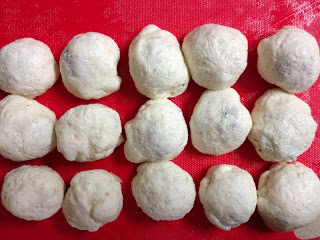 |
| Pulling up the dough | Finished Kubbe balls |
Repeat the process until all the Kubbe balls are done. In our case this recipe made 34 Kubbe balls.
Put It All Together
Make sure the soup is up to a rapid boil. Add the Kubbe balls one at a time into the boiling soup. Make sure the soup is boiling when you add each ball, as adding the Kubbe balls will bring down the temperature each time. So add them quickly, but wait before adding each one if the soup is not boiling yet.
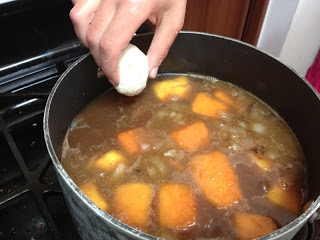 |
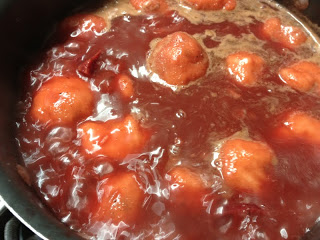 |
| Adding a Kubbe to the soup (Pumpkin) | Kubbe balls rise during cooking (Beet) |
Stir the pot occasionally, and cook for about half an hour. Taste one kubbe ball to make sure it’s cooked properly.
Serve over a bed of rice, or in a bowl as soup.
I’ll repeat those pictures of the finished product from above:
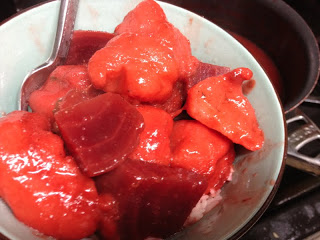 |
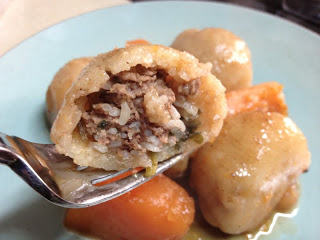 |
| Kubbe Selek (Beet) | Kubbe Dlaat (Pumpkin) |
So special thanks to my mother-in-law for teaching my wife how to make Iraqi Kubbe. Thank you as well to my wife who put up with me taking photos with my phone while she made the Kubbe.
If you like this recipe, let me know in the comments. If you make this recipe, I definitely want to hear about it (send a picture too). Know any other interesting Iraqi recipes, please share. If anything isn’t clear, let me know and I’ll try to fix it.

My mother was a Kurdish Jew for the Iraqi region of Kurdistan. As a young child I remember sitting on the kitchen floor with her learning to stuff the dough. We grew up with the traditional Kurdish version of the soup which was a rich chicken stock heavily spiced with turmuric. I learned the red/beet/sweet-sour and pumpkin versions from my Iranian-Jewish aunt. Her family would have the Baharat ground together at the shook in large batches which would then be passed on to various family members. This is the best page I have ever seen breaking down kubbeh and these soups. Thank you!
Rose,
Thank you very much. Do you still make Kubbeh? How does this version compare to what you remember of your aunt’s? I’d love to hear about your mother’s Kurdish version.
All the best,
Philip